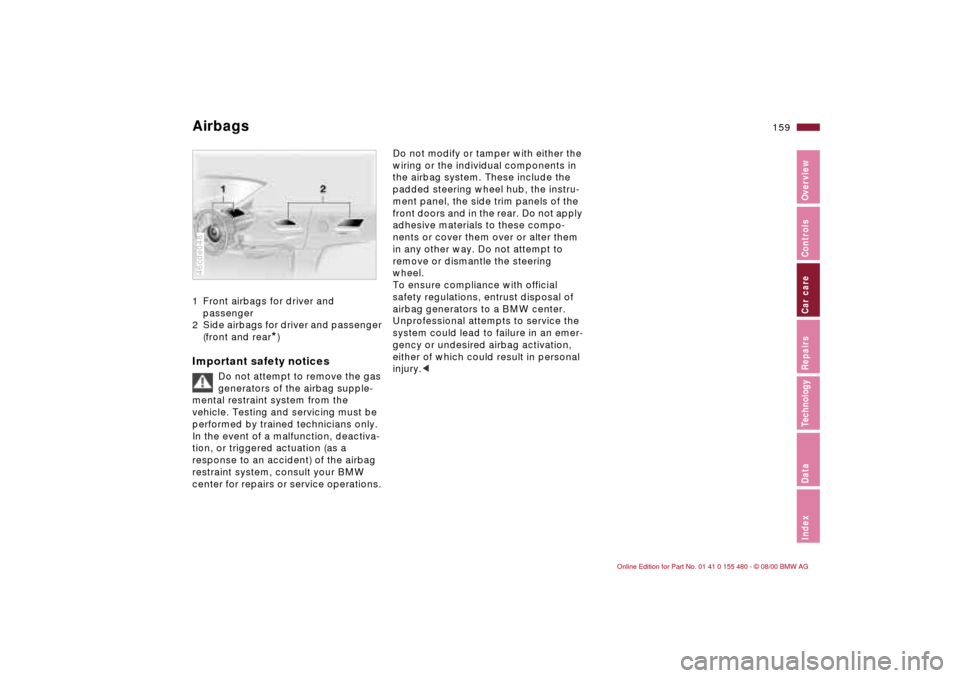2001 BMW 330Ci CONVERTIBLE steering wheel
[x] Cancel search: steering wheelPage 128 of 215

128n
Winter operationBrakesWinter road conditions substantially
reduce the amount of traction available
between the tires and the road surface;
the resulting increase in braking
distance is considerable and should
always be kept in mind.
ABS is intended to prevent the wheels
from locking during brake applications,
thus helping to maintain vehicle stability
and steering response.
If the ABS does not respond in a critical
braking situation and the wheels lock:
reduce the pressure on the brake pedal
until the wheels just start to roll again
while still maintaining enough force to
continue braking.
Then increase the pressure, reduce the
pressure when the wheels lock, reapply
pressure etc.
This staggered braking procedure will
reduce stopping distances while
helping you maintain steering control.
You can then attempt to steer around
hazards after you have reduced pres-
sure on the brake pedal.Do not shift down on slick road
surfaces. Doing so could cause
the rear wheels to lose traction and
skid, that could result in the loss of
vehicle control.<
Depress the clutch during hard
braking on road surfaces that
provide only poor or uneven traction.<
Skid control Depress the clutch and let up on the
accelerator pedal, or place the selector
lever for the automatic transmission in
the "Neutral" position. Countersteer
carefully and attempt to regain control
of the vehicle.
ParkingEngage 1st or reverse gear. If your
vehicle is equipped with an automatic
transmission, place the selector lever in
"Park." On vehicles with manual trans-
mission, also apply the parking brake
when parking on inclined surfaces. In
order to prevent the parking brake pads
from locking due to frost or corrosion,
dry them by gently applying the parking
brake as the vehicle is coming to a
stop. Make sure that following traffic is
not endangered.
The brake lamps do not come
on when the parking brake is
applied.<
Page 136 of 215

136n
Winter tiresChoosing the right tireBMW recommends winter tires (M+S
radial tires) for driving in adverse winter
road conditions. So-called all-season
tires with the M+S identification mark
do indeed possess better winter trac-
tion than summer tires that have the H,
V, W, Y and ZR speed ratings, but they
generally fail to provide the same levels
of performance as winter tires.
In the interest of safe tracking and
steering response, install winter tires
made by the same manufacturer having
the same tread configuration on all four
wheels.
Mount only winter tires which have
been approved by BMW. Any BMW
center will be glad to provide you with
information on the best winter tires for
every particular driving condition.
Do not exceed specified
maximum speeds
Never exceed the maximum speed
for which the tires are rated.
Unprofessional attempts by laymen to
service tires can lead to damage and
accidents.
Have this work performed by skilled
professionals only. Any BMW center
has the required technical knowledge
and the proper equipment and will be
happy to assist you.<
Tire condition, tire pressureWinter tires display a perceptible loss in
their ability to cope with winter driving
conditions once the tread wears to
below 0.16 in (4 mm), and therefore in
the interest of safety, should be
replaced.
Comply with the specified tire inflation
pressures Ð and be sure to have the
wheel and tire assemblies balanced
every time you change the tires.
StorageAlways store tires in a cool, dry place.
Store them away from light whenever
possible. Protect the tires against
contact with oil, grease and fuel.Snow chains
*
Use narrow-link BMW snow chains
on
winter tires only in pairs and only on the
rear wheels. Comply with all manufac-
turer's safety precautions when
mounting the chains.
Page 159 of 215

159n
IndexDataTechnologyRepairsCar careControlsOverview
Airbags 1 Front airbags for driver and
passenger
2 Side airbags for driver and passenger
(front and rear
*)
Important safety notices
Do not attempt to remove the gas
generators of the airbag supple-
mental restraint system from the
vehicle. Testing and servicing must be
performed by trained technicians only.
In the event of a malfunction, deactiva-
tion, or triggered actuation (as a
response to an accident) of the airbag
restraint system, consult your BMW
center for repairs or service operations.
46cde048
Do not modify or tamper with either the
wiring or the individual components in
the airbag system. These include the
padded steering wheel hub, the instru-
ment panel, the side trim panels of the
front doors and in the rear. Do not apply
adhesive materials to these compo-
nents or cover them over or alter them
in any other way. Do not attempt to
remove or dismantle the steering
wheel.
To ensure compliance with official
safety regulations, entrust disposal of
airbag generators to a BMW center.
Unprofessional attempts to service the
system could lead to failure in an emer-
gency or undesired airbag activation,
either of which could result in personal
injury.<
Page 173 of 215

173n
IndexDataTechnologyRepairsCar careControlsOverview
Changing a wheel
Take these precautionary
measures if you have either a flat
tire or are changing the tire:
Stop the vehicle as far as possible from
passing traffic. Park on a firm, flat
surface. Switch on the hazard warning
flashers. Turn the steering wheel to the
straight-ahead position, remove the key
and engage the steering lock. Shift into
1st or reverse gear (selector lever in
"Park" with automatic transmission) and
engage the parking brake.
All passengers should be outside the
vehicle and well away from your imme-
diate working area (behind a guardrail,
for instance).
Set up a warning triangle
* or portable
hazard warning on the roadside at an
appropriate distance from the rear of
the vehicle. Comply with all safety
guidelines and regulations.
Change the wheel only on a level, firm
surface which is not slippery. Avoid
jacking the vehicle on a soft or slippery
support surface (snow, ice, loose
gravel, etc.), as it could slide sideways.
Position the jack on a firm support
surface.
Do not place wooden blocks or similar
objects under the jack. If this is done,
the jack might not be able to reach its
full support capacity because of the
limited height.
Do not lie under the vehicle or start the
engine when the vehicle is supported
by the jack. Failure to comply with this
creates a risk of fatal injury.<
Your BMW has a space-saver spare tire
for temporary use to ensure your
mobility.
To remove the space-saver spare
tire, take out the floor panel in the
luggage compartment completely (refer
to page 41).<
You will need the following:In order to avoid rattling noises later,
note the position of the tools when you
remove them and return them to their
original position when you are through
using them.
>Jack (1)
Raise the floor panel in the luggage
compartment (refer to page 41) and
unclip the jack from where it is stored
(arrow).
After use, swing the crank back and
clip into place.
>Wedge (2)
Located behind the jack on the wall
in the luggage compartment. Loosen
the wing nut to remove it.46cde038
Page 176 of 215

176n
Changing a wheel Battery Driving with the space-saver
spare tireDrive cautiously and do not exceed a
speed of 50 mph (80 km/h).
Be aware that vehicle handling will be
altered. Slower brake response time,
longer braking distances and changed
steering characteristics may be
anticipated when approaching limit
conditions.
The changes in handling characteristics
will be even more pronounced in
conjunction with winter tires.
Only one space-saver spare tire
*
may be mounted at a time. Mount
a wheel and tire with the same size
and specifications as the others at the
earliest possible opportunity. Maintain
correct tire pressures. Refer to
page 28.<
LocationThe battery is located at the right-rear
of the luggage compartment. Remove
the luggage compartment floor panel
(refer to page 40), and give a screw-
driver or a coin a f-turn counter-clock-
wise to release and remove the two
fasteners, plus an additional fastener in
the top center side trim panel. In order
to remove the storage tray, slide the
side trim panel slightly upward.
Battery posts, terminals, and
related accessories contain lead
and lead compounds. Wash hands after
handling.<46cde045
Charge conditionYou can read the charge condition of
the battery with the "Magic Eye"
*
(a hydrometer):
>Green: adequate charge.
>Black: not adequately charged. The
battery must be recharged. Please
contact your BMW center for addi-
tional information.
>Yellow: replace the battery.
The service life specified for the
battery can be achieved only if it is
always kept adequately charged. If the
vehicle is primarily used for stop-and-
go traffic, be sure to check the charge
state more often.<
46cde044
Page 189 of 215

189n
IndexDataTechnologyRepairsCar careControlsOverview
Deceleration sensors continuously
monitor the acceleration forces acting
upon the vehicle. If, as the result of a
frontal collision, a deceleration is
reached at which the protection of the
safety belts alone is no longer
adequate, the gas generators of the
driver and passenger-front airbags are
ignited. However, the passenger-side
airbag is only triggered if an additional
sensor has recognized that the
passenger seat is occupied.
In the event of a side collision, the side
airbags in the front and/or rear
* are
triggered if necessary.
390de012
The airbags located under the marked
covers inflate and unfold in a matter of
a few milliseconds. In this process, they
tear through the designed separation
points of the upholstered covers or
press them out.
Because the inflation process must be
virtually instantaneous, it is accompa-
nied by a certain amount of ignition and
inflation noise, which will be drowned
out by the noise from the accident
itself. The gas required to inflate the
airbags is not dangerous, and the
associated smoke then dissipates.
The entire process is completed within
fractions of a second.Highly sensitive sensors monitor the
number of revolutions of the wheels.
When equipped with DSC, they also
monitor steering angle, lateral accelera-
tion, brake pressure and the movement
of the vehicle around its vertical axis.
If differences in the wheel speeds
occur, ASC+T counteracts the danger
of wheelspin by reducing engine
torque; if necessary, ASC+T will also
respond by applying the brakes to the
rear wheels.
In addition, DSC permanently monitors
the vehicle's current operating condi-
tion and compares it with an ideal
condition that is calculated from the
sensor's signals. If deviations from this
occur (understeering or oversteering,
for instance), DSC can stabilize the
vehicle in fractions of a second by
reducing engine output and with the
assistance of braking intervention at
individual wheels. Dangerous skids are
thus prevented before they can even
start, and all of this is possible, of
course, only within physically possible
limits. You may need some time to
become accustomed to the system's
intervention. However, it provides
optimum drive force and vehicle
stability. The braking intervention may
be accompanied by sounds specific to
the system.
Airbags ASC+T/DSC
*
Page 204 of 215

Everything from A to Z
A
ABS (Antilock Brake System) 22,122
Accessories 6
Activated-charcoal filter 106,180
Adaptive Transmission Control (ATC) 73,188
Adding engine oil 145
Adding washer fluid 144,199
Adjusting backrest 52
Adjusting headrests 53
Adjusting the steering wheel 57
Adjusting the temperature 98,104
Adjusting thigh support 54
Air conditioner 96
Air distribution 98,104
Air nozzles 96,102
Air outlets 96,102
ventilation 96,102
Air pressure, tires 27,132
Air supply 98,105
Airbags 21,61 ,159 ,189
sitting properly with 62
Alarm system 42
Antenna 129
Antenna, Diversity 190 Antifreeze
147
radiator 127
Antilock Brake System (ABS) 22,122
Anti-theft alarm system 42
Aquaplaning 121,132
Armrest 110
ASC+T (Automatic Stability Control plus
Traction) 22,88
Ashtray front 111
rear 112
ATC (Adaptive Transmission Control) 73,188
Attach vacuum cleaner 112
AUC (Automatic recirculated-air
control) 105
Automatic car washes 151
Automatic climate control 102
remove window
condensation 105
Automatic cruise control 79
Automatic dimming, interior rearview mirror 58
Automatic recirculated-air control (AUC) 105
Automatic Stability Control plus Traction
(ASC+T) 22,88 Automatic transmission with
Steptronic 21,73
Automatic windshield washer 77
Average consumption 85
Average speed 86
Avoiding unwanted alarm 43
Axle loads 198
B
Backrest adjusting 52
locking 21,55
releasing 55
Backup lamps 72
bulb replacement 169
Battery 176,200
capacity 200
charge current 20,176
charging 178
discharged 183
removal and
installation 178
Belts 60
Beverage holder 111
Blower 98,105
BMW High Performance Synthetic Oils 146
BMW Maintenance System 150 BMW sports seat
54
Bore 196
Brake fluid 148
Brake hydraulic system 20
Brake lamps, bulb replacement 169
Brake pads 22,126
Brake system 126
Brakes 125
malfunctions 126
Break-in procedures 120
Bulb replacement 166
C
California Proposition 65 Warning 161
Capacities 199
Car Memory 59
Car radio 129
reception 129,190
refer also to the Radio
Owner's Manual
Car washes 151
Care convertible top 157
exterior 152
interior 154
leather upholstery 155
rubber seals and
components 127
Page 207 of 215

Everything from A to Z
207n
IndexDataTechnologyRepairsCar careControlsOverview
Interlock69
Intermittent mode, wiper
system76 J
Jack173
Jump-starting183 K
Key Memory59
Keys32
with remote control32 L
Lamps and bulbs166
LAMPS ON warning93
Lashing eyes115
LATCH attachment of the
child seat64
Leather care155
Length197
License plate lamp, bulb
replacement171
Light-alloy wheels137
Lighter112
Loads, securing114
Load-securing devices115
Low beam headlamps93
bulb replacement167
Lug bolts174 Luggage
compartment40,41
capacity198
emergency release39
floor panel40
lid39
lighting39
lock separately39
remote control36
Luggage compartment
lamps, bulb
replacement172
Luggage rack116
Lumbar support55
M
M+S tires136
Maintenance82,150
Malfunction displays83
Manual convertible top,
operating45
Manual transmission72
Manually controlled
recirculated-air105
Memory57
MFL (Multi-function steering
wheel)24
Microfilter99,180
Mirror memory57
Mirrors57
Mobile phones129 Modifications,
technical6,161
Motion sensor, interior43
Mounting child safety
seat64
Mounting the roof
carrier130
Multi-function steering
wheel (MFL)24
N
Navigation system, refer to
the radio Owner's Manual O
OBD interface socket162
Odometer81
Oil
additives145
capacity199
consumption145
dipstick145
quality146
specifications146
viscosity146
Oil change intervals, see the
Service and Warranty
Information Booklet (US
models)/Warranty and
Service Guide Booklet
(Canadian models) Oil filter change199
Oil level
check145
indicator lamp20
Oil pressure, indicator
lamp20
OILSERVICE82
Onboard tool kit166
Opening and closing
from the inside38
from the outside34
Operating the convertible
top manually in the event
of an electrical
malfunction181
Outside temperature
display84
P
Paint blemishes152
Paint, care152
Paintwork
minor repairs153
waxing153
Park Distance Control
(PDC)87
Parking brake71
Parking help87
Parking lamps94
Parking, winter128